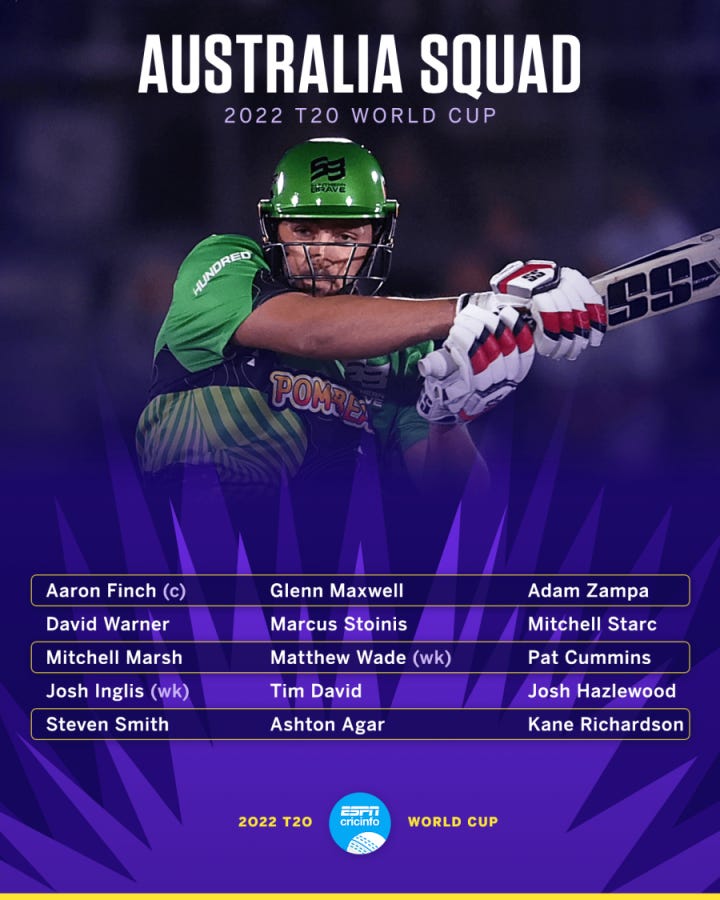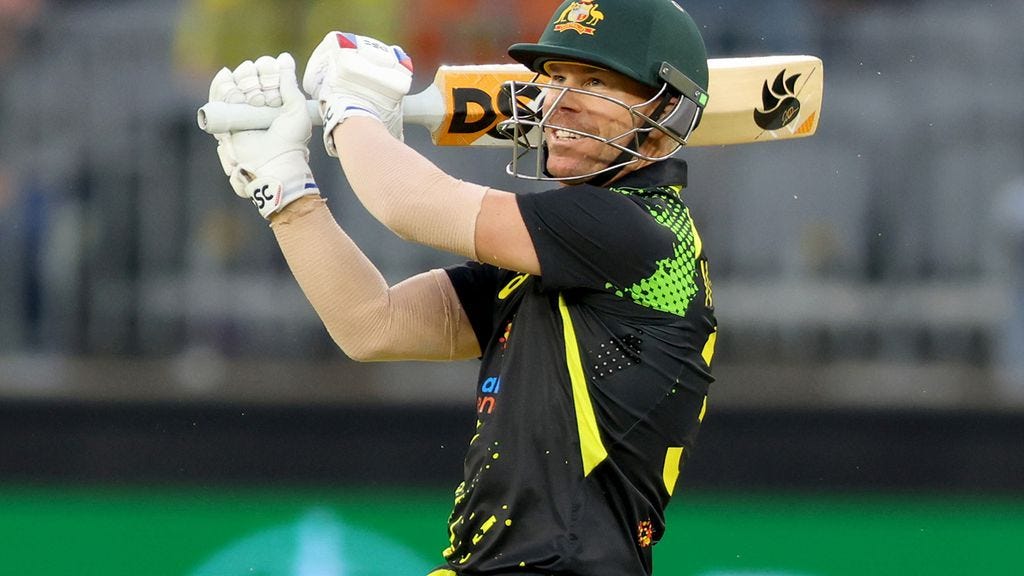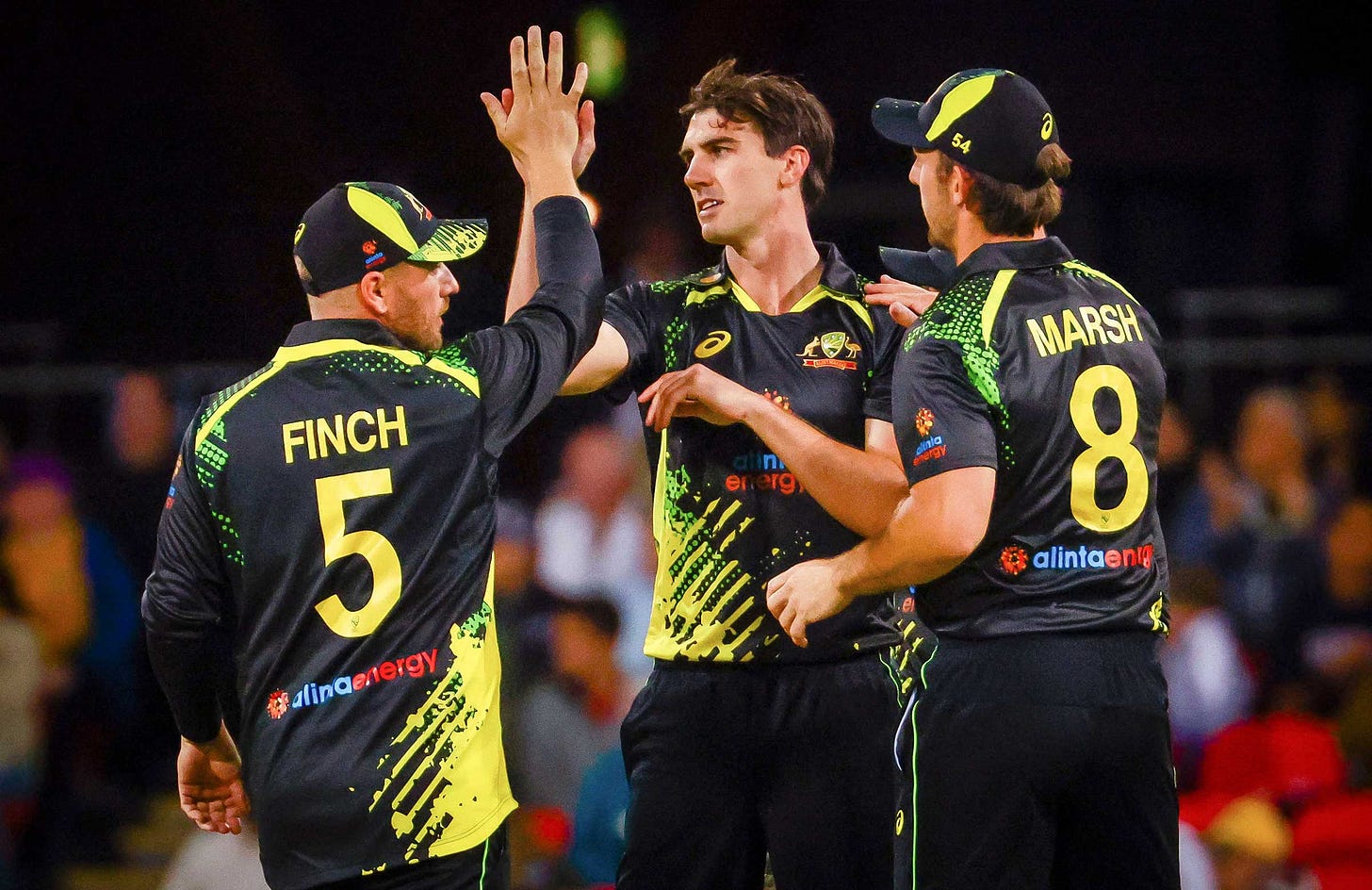Australia preview - ICC T20 World Cup 2022
SpeakingNick's preview of ICC ranked #6 Australia for the upcoming T20 World Cup.
Australia (holders)
ICC Ranking: 6
Australia holds the ICC T20 World Cup; confirmed. Australia, is the ranked sixth team in the ICC T20I rankings; confirmed. An unusual combination! Also — apologies Rob — they are the clear tournament betting favourite. Confusing form-lines to follow. My line — they will be extremely difficult to beat on home soil.
There is no tighter international captain/coach partnership than Aaron Finch and Andrew McDonald. Their association encompasses time as state teammates, domestic captain/coach (Melbourne Renegades), international captain/assistant coach, and now, captain/head coach. Captain Finch will be insistent on delivering McDonald his first trophy as Head Coach, and Coach McDonald will be equally determined to send off Finch as a dual T20 World Cup-winning captain. Both wish for the perfect storm (which we are getting in VIC now!)
SpeakingNick is a reader-supported venture. Free and paid versions are available. The best way to support me is by taking out a paid subscription.
Batting
First to the Australian batting lineup: loaded with experience, skill, and power. David Warner is likely to be their barometer; his powerplay batting is as good as anyone in world cricket, his real strength, though, is his ability to maintain momentum in overs seven to 10, and bat deep into the innings.
At 35, David Warner, is still one of the very best ball-strikers in world cricket. His horizontal bat-swing is as pure as spring water, and he plays Australian wickets like Kenny G plays the saxophone; effortlessly. I’m not sure of Kenny G’s track ability. Warner, though, runs like the wind, and is an insistent pain to opposition fielders. Cricket IQ can be hard to measure subjectively; in Warner, it is easy. He is clearly in command of his own space and the one occupied by his partners and team.
Is Aaron Finch a complimentary opener to Warner? I’m unsure. The question is how Finch should play and in what position. For me, he must open. His method will benefit from a strong shot of self-belief and a wider shot-focus. Right now, it appears hand-cuffed by a single thought process — hitting over the in-field. Finch is better than this. I say: use the floor as well as the aerial route, open up more scoring options. If he can trust his hands, and feet, he has a chance of going out the way he should. Captain — express yourself, please.
Mitch Marsh looks likely to hold down the three-spot. Replicating his form from the previous campaign will be the focus — that form was excellent. Today, he presents as strong and focused, and his ball-striking is as crisp as ever. Tomorrow, hold your breath. Fitness will always be a worry, for now, though, he looks cherry-ripe. Breathe out — again.
Glenn Maxwell and Marcus Stoinis will occupy positions in the top six — presuming Matthew Wade will bat in the seven-spot — in what order, we shall see. Maxwell looks devoid of his white-ball powers with no runs to speak of and isn’t presenting a threat to the opposition. Fear not; he can flick the switch at any moment. However, his run of form will need to be reversed sooner, rather than later.
Stoinis will offer plenty: ‘ the hulk’ will be flexing his proverbial’s. Brooding, photogenic, self-absorbed — the list goes on — Stoinis, though, is a fierce competitor, and nobody craves the pivotal moments more. Perhaps it is self-fulfilling. Still, he remains an instrumental player in this Australian team.
New kid on the block, Tim David, shapes as a likely ally to Matthew Wade. David is a power-hitter built from the new-age mould. Both, he and Wade will be engaged to close-out innings, whether setting totals or chasing them down. Their right-left combination will likely harmonise the execution required in this demanding role. David will play the part of enforcer, and Wade, the agitator.
If Wade has any political ambitions, I suspect he might be a prime recruit for Australia’s republican movement. Coach McDonald holds great faith in the combative Wade; he seems to be the eyes and ears that management will need on the ground and in the dressing room.
Profiling Steve Smith as a backup player seems ludicrous; this is how it looks, though. Smith, shuffled back in the pack and with his role unclear, might be a spectator for much of the tournament. Pretty handy card to have up the sleeve!
In summary: Australia’s success with the bat will be contingent on two factors: Warner’s powerplay batting, then his switch to the ‘pilot role’: and then how many of the power-hitters can fire simultaneously. Also, not to leave too much to the Republican, Matthew Wade. And some Maxwell magic will help things along.
Enjoying the read? If you feel like it, I’d love if you’d share this post with your friends! Or, if you received it from a friend, please forward on to another.
Bowling
Australia’s bowling group appears reliant on pace; Starc, Cummins, and Hazelwood form a dependable troika; they are likely to shoulder a burdensome load. Support will arrive in the way of all-rounders — with no backup quick — and spin; is in the nifty fingers of Adam Zampa, and to a lesser degree, Ashton Agar.
It’s like playing blackjack: the dealer gives you two sevens, you choose not to split them, then twist and receive a third seven to beat the house. Mitchell Starc, Pat Cummins, and Josh Hazlewood give you this type of competitive advantage.
There is no better pace trifecta in world cricket.
Starc provides left-arm bias, consistently high ball-speed, and variation from both sides of the stumps — to right and left handers alike. The propensity to produce elite balls* — to knock over any top-order batter in world cricket — sets him apart, and defines his role. Later over defence is susceptible, although, when his yorker is functioning, watch out.
Hazelwood, number one ranked bowler, and Cummins both hit hard lengths* consistently, that’s an understatement, I know. They also both use the crease to vary angles, and target the stumps more than most. Hazelwood can be dynamic in the powerplay; by restricting scoring, and creating wicket opportunities. The hard overs, and closing will be where Cummins will factor. I expect the bigger boundaries to help his off-speed-into-the-wicket variations.
Augmenting the trio will be Marcus Stoinis, and possibly Mitch Marsh with their medium-pace. Stoinis — like his batting — is able to slot in anywhere. He might bowl powerplay overs, through the middle, or be used at the death. What was once predictable, is now brimming with variations. Watch, and compare, with India’s Hardik Pandya — I expect them both to have big tournaments.
Wrist spin is a religion in Australia; pace, bounce, and substantial boundaries give all wrist-spinners cause for optimism. The rising star of Adam Zampa might not have reached its peak yet, but it is most certainly on the ascent. Zampa has discarded inconsistency, replacing it with assertive right-arm leg spin and a wicked wrong-un (that sounds so wrong). The stumps always look directly at his deliveries — “you miss, and I hit” — being Zampa’s mantra.
Scorned with equal enthusiasm is the practice of finger spin. So, with this in mind, we wish Ashton Agar all the best. No, joking aside, Agar might not see much game time. However, if he does, he will manage his quota adequately. He does have Zampa covered with the bat in hand.
Fielding (defence)
More to follow here. I plan to go back over all the teams previewed with a quick-hit summary. Fielding (defence) will be featured, as well as a deeper dive into stats, both player, and team based.
Australian squad for ICC T20 World Cup: Aaron Finch (c), Ashton Agar, Pat Cummins, Tim David, Josh Hazlewood, Josh Inglis, Mitchell Marsh, Glenn Maxwell, Kane Richardson, Steven Smith, Mitchell Starc, Marcus Stoinis, Matthew Wade, David Warner, Adam Zampa.
That’s it for Australia. More to follow on the rest.
As always, thank you for being here.














